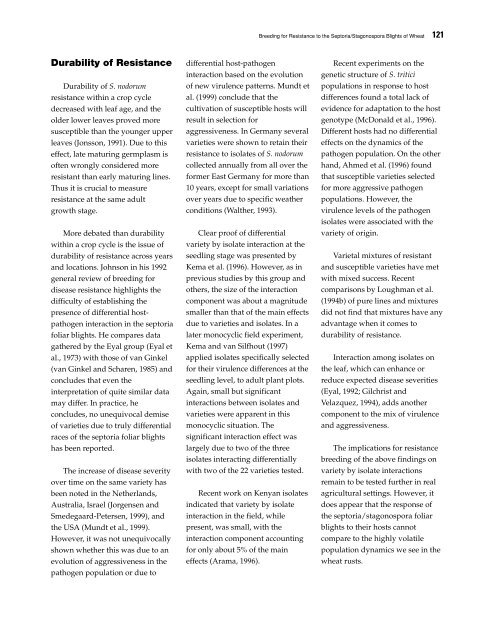Septoria and Stagonospora Diseases of Cereals - CIMMYT ...
Septoria and Stagonospora Diseases of Cereals - CIMMYT ...
Septoria and Stagonospora Diseases of Cereals - CIMMYT ...
You also want an ePaper? Increase the reach of your titles
YUMPU automatically turns print PDFs into web optimized ePapers that Google loves.
Durability <strong>of</strong> Resistance<br />
Durability <strong>of</strong> S. nodorum<br />
resistance within a crop cycle<br />
decreased with leaf age, <strong>and</strong> the<br />
older lower leaves proved more<br />
susceptible than the younger upper<br />
leaves (Jonsson, 1991). Due to this<br />
effect, late maturing germplasm is<br />
<strong>of</strong>ten wrongly considered more<br />
resistant than early maturing lines.<br />
Thus it is crucial to measure<br />
resistance at the same adult<br />
growth stage.<br />
More debated than durability<br />
within a crop cycle is the issue <strong>of</strong><br />
durability <strong>of</strong> resistance across years<br />
<strong>and</strong> locations. Johnson in his 1992<br />
general review <strong>of</strong> breeding for<br />
disease resistance highlights the<br />
difficulty <strong>of</strong> establishing the<br />
presence <strong>of</strong> differential hostpathogen<br />
interaction in the septoria<br />
foliar blights. He compares data<br />
gathered by the Eyal group (Eyal et<br />
al., 1973) with those <strong>of</strong> van Ginkel<br />
(van Ginkel <strong>and</strong> Scharen, 1985) <strong>and</strong><br />
concludes that even the<br />
interpretation <strong>of</strong> quite similar data<br />
may differ. In practice, he<br />
concludes, no unequivocal demise<br />
<strong>of</strong> varieties due to truly differential<br />
races <strong>of</strong> the septoria foliar blights<br />
has been reported.<br />
The increase <strong>of</strong> disease severity<br />
over time on the same variety has<br />
been noted in the Netherl<strong>and</strong>s,<br />
Australia, Israel (Jorgensen <strong>and</strong><br />
Smedegaard-Petersen, 1999), <strong>and</strong><br />
the USA (Mundt et al., 1999).<br />
However, it was not unequivocally<br />
shown whether this was due to an<br />
evolution <strong>of</strong> aggressiveness in the<br />
pathogen population or due to<br />
differential host-pathogen<br />
interaction based on the evolution<br />
<strong>of</strong> new virulence patterns. Mundt et<br />
al. (1999) conclude that the<br />
cultivation <strong>of</strong> susceptible hosts will<br />
result in selection for<br />
aggressiveness. In Germany several<br />
varieties were shown to retain their<br />
resistance to isolates <strong>of</strong> S. nodorum<br />
collected annually from all over the<br />
former East Germany for more than<br />
10 years, except for small variations<br />
over years due to specific weather<br />
conditions (Walther, 1993).<br />
Clear pro<strong>of</strong> <strong>of</strong> differential<br />
variety by isolate interaction at the<br />
seedling stage was presented by<br />
Kema et al. (1996). However, as in<br />
previous studies by this group <strong>and</strong><br />
others, the size <strong>of</strong> the interaction<br />
component was about a magnitude<br />
smaller than that <strong>of</strong> the main effects<br />
due to varieties <strong>and</strong> isolates. In a<br />
later monocyclic field experiment,<br />
Kema <strong>and</strong> van Silfhout (1997)<br />
applied isolates specifically selected<br />
for their virulence differences at the<br />
seedling level, to adult plant plots.<br />
Again, small but significant<br />
interactions between isolates <strong>and</strong><br />
varieties were apparent in this<br />
monocyclic situation. The<br />
significant interaction effect was<br />
largely due to two <strong>of</strong> the three<br />
isolates interacting differentially<br />
with two <strong>of</strong> the 22 varieties tested.<br />
Recent work on Kenyan isolates<br />
indicated that variety by isolate<br />
interaction in the field, while<br />
present, was small, with the<br />
interaction component accounting<br />
for only about 5% <strong>of</strong> the main<br />
effects (Arama, 1996).<br />
Breeding for Resistance to the <strong>Septoria</strong>/<strong>Stagonospora</strong> Blights <strong>of</strong> Wheat 121<br />
Recent experiments on the<br />
genetic structure <strong>of</strong> S. tritici<br />
populations in response to host<br />
differences found a total lack <strong>of</strong><br />
evidence for adaptation to the host<br />
genotype (McDonald et al., 1996).<br />
Different hosts had no differential<br />
effects on the dynamics <strong>of</strong> the<br />
pathogen population. On the other<br />
h<strong>and</strong>, Ahmed et al. (1996) found<br />
that susceptible varieties selected<br />
for more aggressive pathogen<br />
populations. However, the<br />
virulence levels <strong>of</strong> the pathogen<br />
isolates were associated with the<br />
variety <strong>of</strong> origin.<br />
Varietal mixtures <strong>of</strong> resistant<br />
<strong>and</strong> susceptible varieties have met<br />
with mixed success. Recent<br />
comparisons by Loughman et al.<br />
(1994b) <strong>of</strong> pure lines <strong>and</strong> mixtures<br />
did not find that mixtures have any<br />
advantage when it comes to<br />
durability <strong>of</strong> resistance.<br />
Interaction among isolates on<br />
the leaf, which can enhance or<br />
reduce expected disease severities<br />
(Eyal, 1992; Gilchrist <strong>and</strong><br />
Velazquez, 1994), adds another<br />
component to the mix <strong>of</strong> virulence<br />
<strong>and</strong> aggressiveness.<br />
The implications for resistance<br />
breeding <strong>of</strong> the above findings on<br />
variety by isolate interactions<br />
remain to be tested further in real<br />
agricultural settings. However, it<br />
does appear that the response <strong>of</strong><br />
the septoria/stagonospora foliar<br />
blights to their hosts cannot<br />
compare to the highly volatile<br />
population dynamics we see in the<br />
wheat rusts.









